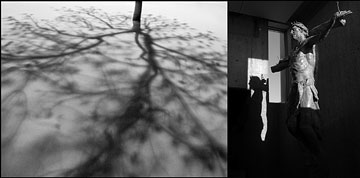Tale of two shadows: from despair to new year of hope
COFFEE WITH WARREN, with Warren Harbeck
Cochrane Eagle, December 31, 2008
Events of the past few months have cast a shadow of gloom over what has traditionally been a season of happiness. The cholera outbreak in Zimbabwe has grabbed international attention, as have the recent terrorist assault on Mumbai, India, and the renewed hostilities in the Gaza Strip. The global economic downturn has also left its mark, with many losing jobs, homes, and life savings. These and other dark concerns have caused some to fall into despair at the very thought of entering a new year.
What possible joy can be found in such shadows? Can there be any positive side to the shadows and darkness? Might there be shadows that are harbingers of hope?
Take winter, for instance. When people I meet around town seem distressed over the arrival of dark, cold, snowy days, I like to respond: “Yes, but winter is a sure sign that spring is just around the corner.”
Then there’s that impassioned statement by Martin Luther King, Jr.: “Don’t worry about the darkness, for that is when the stars shine brightest.”
Speaking of King, I’ve been reflecting lately on the Baptist minister’s “I Have a Dream” speech, widely regarded as one of the greatest speeches in history. Here was a shadow of hope, if there ever was one.
On Aug. 28, 1963, the American civil rights champion stood on the steps of the Lincoln Memorial in Washington, D.C., and addressing over 250,000 gathered for the March on Washington, proclaimed a new day of hope in the midst of the nation’s racial darkness. The darkness tried to extinguish his light through assassination only five years later, but the light he radiated cast an almost inconceivable shadow of hope that will soon be realized: on Jan. 20, 2009, Barack Obama – half Black, half White – will take the oath of office as the 44th president of the United States in an inauguration that stunningly fulfills King’s dream of racial harmony.
“We refuse to believe the bank of justice is bankrupt,” King said. And prophetic of Obama’s ascendance, he added: “I have a dream that my four little children will one day live in a nation where they are not judged by the color of their skin, but by the content of their character.”
All this brings me around to two photos of shadows my wife and I took recently.
The one Mary Anna took was of the Christmas Eve shadow of the ash tree on our snow-covered lawn. The shadow, created by the streetlight overhead, hinted not only at what the tree had been in previous years, but at what it promises to be when light and warmth return to a dark and frozen landscape, the snow melts, and lush green leaves once more triumph over seeming death and despair.
The photo I took was of the “Tree-of-Life Crucifix” in the Day Chapel of St. Mary’s Catholic Church in Cochrane. It was at the noon hour just prior to the winter solstice, that turning point of the year in the northern hemisphere when the days start getting longer as darkness yields to light.
The rays of the low-lying sun were streaming through the narrow window immediately to the south of the crucifix, casting the shadow of Jesus’ bruised head onto the opposite wall. This was a reminder to me as a Christian that those, like King, who stand in the shadow of the Crucified One can themselves be turning points in history – agents of justice and hope “taken and blessed, broken and shared by Christ,” as Rory Cooney’s visionary communion hymn goes, “that the world might live.”
Such shadows are harbingers of hope for the New Year. Let us embrace them and take heart.
Two shadowy images point to hope for the future: “Christmas Eve Shadows on Snowy Lawn,” by Mary Anna Harbeck, and “The Shadow of the Crucified One,” by Warren Harbeck. Click to see a larger version.
© 2008 Warren Harbeck
JoinMe@coffeewithwarren.com
